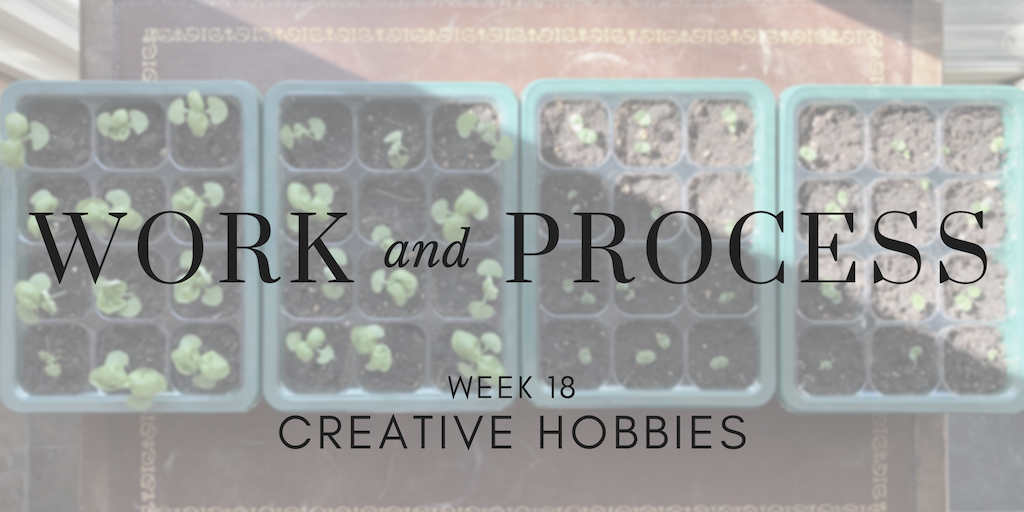|
Spring is here. The little crabapple tree I’m trying to turn into a bonsai is leafing out. After I finally figured out that I needed to fertilize it, the spearmint that’s been struggling on my windowsill for two years is finally thriving. I’m starting forty-eight basil plants from seed in hopes that enough will survive so I can achieve my lifelong (okay, decades-long) dream of being able to periodically harvest my own basil for fresh pesto. All of a sudden, after a lifetime track record of killing every plant that’s ever had the misfortune of being under my care, I’ve somehow become a gardener.
This transformation didn’t happen overnight, of course. It started maybe six or seven years ago when I was given my first moth orchid, which, contrary to popular belief, has a care routine so regular and predictable that even I could keep it alive. (If you’re curious, see the end of the post for details!) Slowly, I acquired more orchids, then branched out into air plants, bonsai (or what will become bonsai in like 10-20 years, I hope), and indoor herbs. I like the creativity of gardening, particularly with the bonsai, which I’m trying to figure out how to train as well as grow, and I get to be a problem-solver, learning if it’s sun or water or fertilizer the plants need more or less of, trying to determine why the leaves are wilting like that, what the proper soil mixture is, where the plants are happiest during what times of the year. But I’ve had a lot of creative hobbies over the years (drawing, music, book-making, egg-painting), and while I still turn to them occasionally, it’s gardening that’s taken up more and more of my creative free time. And I think that it has to do with my career. Everyone’s experiences are different, of course, but for me, a strange thing happened when I started writing novels professionally. Writing, which had always been a fun creative outlet, a hobby, something I pursued not because it was my job but because I loved it, suddenly became the thing I did because I had to. Without a doubt, I still loved it (and still do), but it had also become an obligation, a responsibility, something I did not because I was inspired, necessarily, but because I wanted to get paid. Which was fine. I welcomed it. I had always wanted to do this work, and I was so grateful and fulfilled because I was actually getting to do it. What I didn’t expect and have been struggling with for a few years, though, was that becoming a professional author not only changed my relationship to my writing, but it also changed my relationship to all my other creative hobbies. For me, becoming a professional author didn’t just mean getting paid to write the books, but it also meant promoting the books, and that’s where things started to get weird for me. Perhaps the most difficult part of this job for me has been navigating social media. I’m naturally a private, introverted person, most comfortable talking one-on-one with someone and kind of super terrified of trying to engage with a lot of people at once, so figuring out how to be in public online has been a huge challenge for me. Of course, I think professional authors do this in various ways--some are brilliant at joining communities or engaging with their readers or building their brands and platforms, some are hardly on social media at all--but for me, who was a new author in 2015-2016 and who often feels like a new author today, I felt (and still feel) this huge pressure to do better with my online platforms. There’s always this low-key buzz of anxiety in the back of my brain, sometimes even when I’m doing the bulk of my job, which is writing the books. How can I get more followers? How can I attract more readers? How can I get more likes/retweets/comments/replies? What am I going to post on Instagram? Will anyone pay attention? Should I be on Twitter more? How do I increase my engagement? Am I failing? Why does it always feel like I’m failing? And in this strange and stressful whirlwind of insecurities, it feels like everything I do should be performative in some way. If I come across some wildflowers, Instagram. If I have a funny thought about a TV show, Twitter. If I do my hair and makeup that day, selfie (or because I’m terrible at selfies, make someone else take a flattering photo of me, which almost invariably ends up being both time-consuming and an exercise in self-criticism). If I’m painting eggs, I can do designs inspired by book covers! If I’m baking, I can post cookies, cupcakes, muffins! We can bond over our shared love of baked goods, can’t we? If I’m drawing, I can post photos of my sketches! Look, everyone, I’m artistic! That’s a brand, right? Am I cool on the internet yet? In this weird, stressed-out brain of mine, not only had writing turned into a job, but so had all of the other fun, creative hobbies that I’d ever pursued, and that made them not fun anymore, not relaxing, not creative outlets that I wanted to keep doing but chores that I had to do because if I didn’t do them, I wasn’t doing the promotional part of my job, I was letting opportunities slide past, I was failing. And then I started gardening more. The trick, I found, is not being very good at it. I’m not a great photographer, and my plants are pretty ugly (because I’m not a great gardener either), so I’m never really tempted to share them or use them as social media content. My plants aren’t photo opportunities. They’re just my plants. This hobby isn’t an avenue for promotion. It’s just a hobby. And for me, at least, that’s been so freeing. My brain has something to chew on when it’s not actively working on a story. I can do something creative that I don’t feel the pressure to incorporate into my act. I don’t know if I’m the only one who feels this way, but for me, it’s nice to have a creative space where I don’t have to worry about reviews, judgments, comparisons, or competitions. I just work on it, and some plants live and some plants die and some plants flourish and some plants struggle, but I’m not stressed out over whether or not I’m failing or falling behind. I just keep doing it, and it’s relaxing and challenging and makes me content. This is something I’ve realized lately that I need. I love writing books and getting paid to do it, but I also think I need a protected creative space away from being the business of being an artist. Don’t get me wrong, the anxious churn of doubts and insecurities about my online presence (or lack thereof) is still there, and still frightening, and still distracting--having a creative hobby doesn’t help that. But having a creative hobby where I don’t feel the pressure to perform or to sell is nourishing to my creative spirit, which I need if I want to keep doing the main part of the job, writing. It will, I think (I hope), make this career more sustainable mentally and emotionally and artistically, so I can keep doing this thing that I love. Next week: KNOWING YOUR PROCESS. Next week I’d like to talk about artistic instincts--how we get them, how we can use them, what they tell us about our creative endeavors, how to listen to them. Join the party next Sunday at tracichee.com and/or post your own responses with the hashtag #workandprocess. BYO cheer. <3 Work and Process is a year-long journey of exploring and reflecting on the artistic process, craft, and working in a creative field. Each Sunday, I’ll post some thoughts, wonderings, explanations, and explorations on writing and creativity, and by the end of it, I hope to have 52 musings, examinations, meanderings, discoveries, bits of joy or inquisitiveness or knowledge to share. In each post, I’ll also include a topic for the following week, so if you happen to be inspired to question/wonder at/consider your own work and process, you’re welcome to join me. We’ll be using the #workandprocess hashtag across all social media platforms, and I hope we find each other to learn and connect and transform on our creative wanderings. How I Keep Moth (Phalaenopsis) Orchids Alive Light: I’ve kept my orchid in a west-facing alley window and an east-facing one, in northern California where the sun wasn’t super intense at either time of the day, but was still pretty consistent. Light’s never really been that big of an issue for my orchids, though. Mostly, I feel like they should be getting some light but not the kind that will fry them. You know that feeling like when you go outside in the afternoon and you’re just getting cooked? They don’t like that. If they’re getting enough light, their leaves will be a nice bright green (somewhere between the green crayon and the light green crayon colors). If the leaves start to turn more yellow or have brown spots, they’re getting too much light. If the leaves start to turn dark green, they’re not getting enough. Start by putting them somewhere with some light (near a window, for example) and they’ll tell you whether it’s too much, not enough, or just right. Water: Watering is a little trickier, but not much. It depends on what your orchid is potted in. A lot of orchids from the grocery store come packed with a bunch of sphagnum moss, which holds a lot of water. People will tell you to put an ice cube on the moss (never touching the plant) once a week, and I’ve kept orchids alive this way. (The thing is, orchids are tropical plants and don’t super like cold, so this isn’t my preferred method of watering them.) Usually, after the flowers fall off and the spike (stem) turns brown, I cut the spike at the base, then repot the orchid in bark and a plastic pot with quite a few drainage holes (I used Google to teach me how to repot). The orchid bark holds some water, which is good, but doesn’t keep the roots soaking, which is bad and can drown/kill the plant. With my orchids potted in bark, I soak them for 10 minutes once a week, let them drain in the sink, and then put them back near the window. The bark should dry out over the course of the week, but if the pot feels heavy, like it still has a bunch of water still in it, I skip the soak that week and wait until the pot feels lighter the next time. I know that’s a huge paragraph, but basically, it’s pot in bark, soak 10 minutes once a week and drain. That’s it! Temperature: Temperature should probably be considered, but I’ve never had a problem with it. I think whatever we’d generally consider comfortable temperatures is what these orchids like, somewhere around 60-70 degrees Fahrenheit, although dipping a little above or below every so often hasn’t hurt my plants yet! Comments are closed.
|
ARCHIVES
February 2024
CATEGORIES |


 RSS Feed
RSS Feed